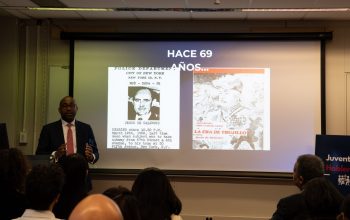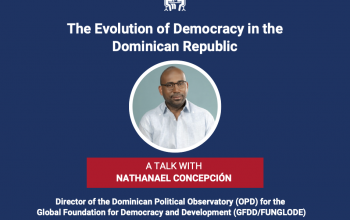news
“The Latino Vote in the US Election”, an article by Dr. Leonel Fernández
November 7, 2016
According to polls up to today, Hillary Clinton will be the winner tomorrow, November 8th.
In the final stretch of the US presidential campaign, all indicators point to the vote among the Latino population being decisive in choosing the next resident of the White House – whether it’s the Democratic Party candidate, Hillary Clinton, or her Republican counterpart, Donald Trump.
According to several opinion polls
out just 24 hours prior to voters casting their ballots, Hillary Clinton has an 84 percent chance of becoming the next president of the United States, compared to the scanty 16 percent chance of Donald Trump.
Not that Trump has been completely discarded. But his possibilities are ever more remote in the face of the push and dynamism displayed by Latino voters, who’ve already started to turn out massively to support the Democrat candidate in the early voting
period held in several different states.
This year an unprecedented 27.3 million Latinos are registered to exercise their suffrage on November 8. This is nearly 8 million more voters than when Barack Obama was first elected president in 2008, and four million more than in the last electoral contest for that office in 2012.
This increase stems in the first place, according to studies done by the prestigious Pew Research Center, from young people born in
the United States to Latino parents who have now reached voting age and will exercise their suffrage for the first time in 2016. This segment of the Latino population represents 32 percent of the entire Spanish-speaking population of the United States.
In the second place this increase comes from the 2.2 million naturalized immigrants, who join the new core of voters and constitute a quarter of the Latino population; and, finally, the growing presence of Puerto Ricans
who, owing to the crisis that has plagued their Caribbean island in recent years, have moved in significant numbers to the mainland, especially central Florida, where they can vote in the presidential election.
FROM OBAMA TO HILLARY
In the 2012 presidential election, an overwhelming number of Latino voters –71 percent of them – backed the Democratic candidate, Barack Obama, over the Republican candidate, Mitt Romney.
This
turnout among Latinos was the highest a Democrat candidate had drawn since 1996, when Bill Clinton won support for his reelection from 72 percent of Latino voters.
Back then the Latino vote represented just 10 percent of the totality of the US electorate, and proved decisive in the support Obama recieved in the nine swing states in that election.
Of those nine states, three – Florida, Nevada, and Colorado – became arenas of intense struggle,
but in the end tipped in favor of a Democratic victory.
In 2012, Obama won Florida with 60 percent of the vote, gaining three percentage points over the 57 percent he’d won four years prior.
In Colorado, the support Obama received from the Latino community was 75 percent, 14 percentage points higher than what he’d achieved in 2008, when he won 61 percent of the Hispanic vote.
In Nevada, president Obama received 70
percent of the vote, although in this case he suffered a decrease compared to the 2008 result, when he got 76 percent of the Latino population’s vote.
In short, the support from the Latino community was emphatic in both of president Barack Obama’s electoral victories over his Republican opponents, at a time when the most important issues for the Latino population involved the economy, jobs, education, and health.
Those issues remain
relevant for Latino voters today, but on top of them has been added another that’s of singular importance for the coming electoral contest: immigration. This is due to the vulgar, inconsiderate, and humiliating statements made throughout the campaign by Republican candidate Donald Trump.
He has confirmed on multiple occasions that should he be elected he will proceed to deport the 11 million undocumented migrants living on US soil, and will build a wall on the
border with Mexico, the construction of which will be billed to the US’s southern neighbor, to halt the flow of – according to Trump – rapists and drug traffickers from that country into the United States.
These statements from the Republican candidate, despite the diversity of the Latino population in the US, have nonetheless contributed to mobilizing and unifying the Latino vote in support of Democratic candidate Hillary Clinton, who just a day prior to the
electoral contest enjoys support from more than 70 percent of them.
LATINOS IN 2016
Of the 27.3 million registered Latino voters, it’s expected that some 15 million will in fact turn out at the polls. Most of them, however, are concentrated in three states where the vote is clearly defined in support of either the Democrats or the Republicans: California, New York, and Texas.
But in four of the eight swing
states, the Latino vote makes up at least 15 percent of the electorate: Nevada, Arizona, Florida, and Colorado.
The four remaining swing states – Georgia, Iowa, North Carolina, and Ohio – have a Latino voter base of 5 percent of the electorate overall.
In Nevada, the number of voting Latinos increased from 228,000 in 2008, to 338,000 in 2016, for an increase of 70 percent within just eight years.
In Arizona, the projected number of
Latino voters this year is 1.3 million, that is, nearly 500,000 more than in the 2008 election.
In Florida, where Latinos make up 17 percent of the electorate, the number of eligible voters in their ranks has increased from 2 million in 2008 to 2.8 million today.
One important thing to keep in mind during this electoral contest is that 54 percent of registered Latino voters think the Democratic Party is more concerned with the problems affecting the
Latino community, compared with just 11 percent who say the same for the Republican Party.
According to conventional wisdom, for a US presidential candidate to have a shot at success, he or she needs the backing of at least 40 percent of the Latino vote.
Just a day before US citizens go to the polls to select their next head of state, various projections indicate that Clinton could get up to 290 votes in the electoral college – 20 more than the number
required to win.
On the other hand, the same projections indicate that in the best case, barring some unforeseen circumstance, the ceiling hit by Trump will be 209 votes in the electoral college, 61 less than the number needed to win.
For a Republican electoral miracle to happen, Trump not only must win Arizona, Iowa, Ohio, Utah, North Carolina, Florida, and New Hampshire, but somehow also pull off a victory in at least one of the following states:
Pennsylvania, Nevada, Colorado, Michigan, Wisconsin, Virginia, New Mexico, or Minnesota.
Naturally, at this point that would be practically impossible.
All stars thus seem to be aligned so that at this moment, in the United States, after Barack Obama has become the first black president, Hillary Clinton will now manage to become the first woman president of the world’s most powerful country.
May it be so.






